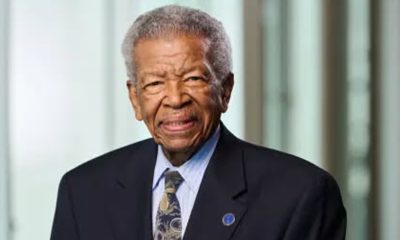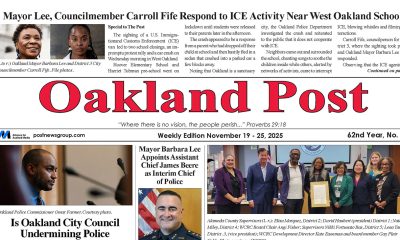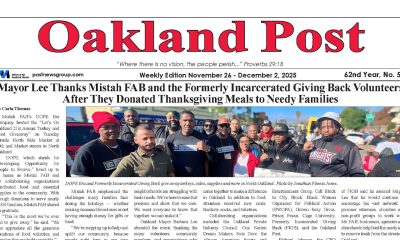National
Court Temporarily Blocks Release of ‘Angola 3’ Inmate

This undated photo provided by the International Coalition to Free the Angola 3 shows Albert Woodfox. Prosecutors sought to keep Woodfox, the last of the “Angola Three,” behind bars Tuesday, June 9, 2015, despite a federal judge’s order to immediately release him after 43 years in isolation, a longer period in lockdown than any other living U.S. prisoner. (Courtesy of International Coalition to Free the Angola 3 via AP)
CAIN BURDEAU, Associated Press
BRIAN SLODYSKO, Associated Press
ST. FRANCISVILLE, La. (AP) — Prison activist Albert Woodfox, the last member of the “Angola Three” inmates held for decades in solitary confinement, will have to wait a bit longer to see if he’ll experience the “immediate” and “unconditional” freedom ordered by a federal judge.
A federal appeals court on Tuesday temporarily blocked the release of Woodfox, who spent more than 40 years in isolation after being accused of killing a guard. His supporters say it was retribution for his Black Panther Party activism to protest prison conditions.
Tuesday’s order came a day after a federal judge ruled that the state can’t fairly try Woodfox, now 68, a third time for the killing of a prison guard 43 years ago, and that the “only just remedy” would be setting him free after all the years he spent in “extended lockdown.”
Woodfox has long maintained his innocence in the guard’s killing, which happened during protests of brutal conditions inside the huge penitentiary built on a former slave plantation in Angola, Louisiana. His two previous convictions were overturned for racial prejudice and lack of evidence.
Louisiana Attorney General Buddy Caldwell is appealing the order by U.S. District Judge James Brady, saying Woodfox is a killer who should remain locked up. The stay by the 5th U.S. Circuit Court of Appeals in New Orleans blocks his release until 1 p.m. Friday, providing time for the court to decide whether to accept the state’s appeal.
Woodfox is currently being held at the West Feliciana Parish Detention Center in St. Francisville, where he was transferred in preparation for a third trial. His attorney, George Kendall, met with Woodfox on Tuesday after the stay was granted.
Kendall said he is “hopeful and optimistic” the court will release Woodfox while the state’s appeal is pending. But he acknowledged the court could order Woodfox to stay in jail while that process plays out.
Kendall described the conditions Woodfox has served his time under as “brutal,” and blasted the attorney general for fighting to keep him incarcerated.
“This case ought to end,” he said.
While not awaiting trial or attending hearings, Woodfox has remained in state prisons. Most of the time was spent at Angola, where for decades an “extended lockdown review board” renewed the decision to hold him in isolation every 90 days, his attorneys say. His attorneys say he was denied contact with the general prison population and kept in a roughly 55-square-foot cell 23 hours a day.
The isolation continued when he was moved to another state prison in 2010.
Amnesty International and the United Nations have condemned Woodfox’s imprisonment as inhumane. Human rights advocates call it a form of torture.
But he has been allowed visitors and reading material, and can see a television through the bars on his cell. State officials dispute that his circumstances constitute “solitary confinement,” saying he is able to communicate with others, including other inmates and chaplains, through the bars of his cell.
“The perception of ‘solitary confinement’ is a far cry from the reality,” said Aaron Sadler, a spokesman for the Attorney General’s office.
Angela Allen-Bell, an assistant professor of legal writing and analysis at Southern University Law Center in Baton Rouge, said she talked with Woodfox on Monday night. She said he has been having panic attacks and is suffering from health problems, including diabetes.
“He does not allow himself to be very optimistic about things. I think that that is a coping mechanism that he has developed. But we talk often about the power of prayer and the ability of God to deliver miracles. And I do believe that he believes that that is possible,” Allen-Bell said.
Woodfox was one of several prisoners accused of killing Brent Miller, a 23-year-old guard at the prison. A year earlier, Woodfox and Herman Wallace helped establish a prison chapter of the Black Panther Party, while Robert King helped establish a Black Panther chapter in the New Orleans prison.
All three were active in hunger strikes and work stoppages that spurred improvements to prison conditions, and all three suffered harsh treatment thereafter as prison authorities kept them isolated at Angola to prevent more disruption behind bars.
Parnell Herbert, a 66-year-old New Orleans playwright and boyhood friend of Woodfox, said that at one point, the Angola Three refused to submit to dehumanizing cavity searches for contraband. They were then taken to a chamber where prison guards beat them with clubs and baseball bats, but they eventually won a battle in court to end the searches.
“Albert told me, ‘They will never break me,'” Herbert said.
In ruling against a third trial, Brady cited the inmate’s age and poor health; the unavailability of witnesses; “the prejudice done onto Mr. Woodfox by spending over forty years in solitary confinement”; and “the very fact that Mr. Woodfox has already been tried twice” before his convictions were overturned.
Wallace died in October 2013, days after a judge freed him and granted him a new trial. King has become a public speaker since his release in 2001 after the reversal of his conviction in the death of a fellow inmate in 1973.
___
Burdeau reported from New Orleans. Associated Press writers Kevin McGill and Rebecca Santana in New Orleans contributed to this report.
___
This story has been corrected to show that Herman Wallace died in October 2013, not last fall.
Copyright 2015 The Associated Press. All rights reserved. This material may not be published, broadcast, rewritten or redistributed.
Activism
Ann Lowe: The Quiet Genius of American Couture
Lowe was born in Clayton, Alabama, into a family of gifted seamstresses. Her mother and grandmother were well-known dressmakers who created exquisite gowns for women in the area. By the time Lowe was a young girl, she was already showing extraordinary talent — cutting, sewing, and decorating fabric with a skill that far exceeded her age. When her mother died unexpectedly, Lowe – only 16 years old then – took over her mother’s sewing business, completing all the orders herself.

By Tamara Shiloh
Ann Cole Lowe, born Dec.14, 1898, was a pioneering American fashion designer whose extraordinary talent shaped some of the most widely recognized and celebrated gowns in U.S. history.
Although she designed dresses for society’s wealthiest families and created masterpieces worn at historic events, Lowe spent much of her life in the shadows — uncredited, underpaid, yet unmatched in skill. Today, she is celebrated as one of the first nationally recognized African American fashion designers and a true visionary in American couture.
Lowe was born in Clayton, Alabama, into a family of gifted seamstresses. Her mother and grandmother were well-known dressmakers who created exquisite gowns for women in the area. By the time Lowe was a young girl, she was already showing extraordinary talent — cutting, sewing, and decorating fabric with a skill that far exceeded her age. When her mother died unexpectedly, Lowe – only 16 years old then – took over her mother’s sewing business, completing all the orders herself. This early responsibility would prepare her for a lifetime of professional excellence.
In 1917, Lowe moved to New York City to study at the S.T. Taylor Design School. Although she was segregated from White students and forced to work separately, she, of course, excelled, graduating earlier than expected. Her instructors quickly recognized that her abilities were far above the typical student, especially her skill in hand-sewing, applique, and intricate floral embellishment – techniques that would become her signature.
Throughout the 1920s and 1930s, she designed gowns for high-society women in Florida and New York, operating boutiques and working for prestigious department stores. Her reputation for craftsmanship, originality, and elegance grew increasingly. She was known for creating gowns that moved beautifully, featured delicate hand-made flowers, and looked sculpted rather than sewn. Many wealthy clients specifically requested “an Ann Lowe gown” for weddings, balls, and galas.
Her most famous creation came in 1953: the wedding gown worn by Jacqueline Bouvier when she married Massachusetts Sen. John F. Kennedy. The dress – crafted from ivory silk taffeta with dozens of tiny, pleated rosettes – became one of the most photographed bridal gowns in American history. Despite this achievement, Lowe received no public credit at the time. When a flood destroyed her completed gowns 10 days before the wedding, she and her seamstresses worked day and night to remake everything – at her own expense. Her dedication and perfectionism never wavered.
She eventually opened “Ann Lowe Originals,” her own salon on New York’s Madison Avenue. She served clients such as the Rockefellers, DuPonts, Vanderbilts, and actresses like Olivia de Havilland. Yet even with her wealthy clientele, she struggled financially, often undercharging because she wanted every dress to be perfect, even if it meant losing money.
Lowe’s contributions were finally recognized later in life. Today, her exquisite gowns are preserved in museums, including the Smithsonian National Museum of African American History and Culture and the Metropolitan Museum of Art.
In the last five years of her life, Lowe lived with her daughter Ruth in Queens, N.Y. She died at her daughter’s home on Feb. 25, 1981, at the age of 82, after an extended illness.
Activism
Oakland Post: Week of December 10 – 16, 2025
The printed Weekly Edition of the Oakland Post: Week of – December 10 – 16, 2025

To enlarge your view of this issue, use the slider, magnifying glass icon or full page icon in the lower right corner of the browser window.
Alameda County
Seth Curry Makes Impressive Debut with the Golden State Warriors
Seth looked comfortable in his new uniform, seamlessly fitting into the Warriors’ offensive and defensive system. He finished the night with an impressive 14 points, becoming one of the team’s top scorers for the game. Seth’s points came in a variety of ways – floaters, spot-up three-pointers, mid-range jumpers, and a handful of aggressive drives that kept the Oklahoma City Thunder defense on its heels.

By Y’Anad Burrell
Tuesday night was anything but ordinary for fans in San Francisco as Seth Curry made his highly anticipated debut as a new member of the Golden State Warriors. Seth didn’t disappoint, delivering a performance that not only showcased his scoring ability but also demonstrated his added value to the team.
At 35, the 12-year NBA veteran on Monday signed a contract to play with the Warriors for the rest of the season.
Seth looked comfortable in his new uniform, seamlessly fitting into the Warriors’ offensive and defensive system. He finished the night with an impressive 14 points, becoming one of the team’s top scorers for the game. Seth’s points came in a variety of ways – floaters, spot-up three-pointers, mid-range jumpers, and a handful of aggressive drives that kept the Oklahoma City Thunder defense on its heels.
One of the most memorable moments of the evening came before Seth even scored his first points. As he checked into the game, the Chase Center erupted into applause, with fans rising to their feet to give the newest Warrior a standing ovation.
The crowd’s reaction was a testament not only to Seth’s reputation as a sharpshooter but also to the excitement he brings to the Warriors. It was clear that fans quickly embraced Seth as one of their own, eager to see what he could bring to the team’s championship aspirations.
Warriors’ superstar Steph Curry – Seth’s brother – did not play due to an injury. One could only imagine what it would be like if the Curry brothers were on the court together. Magic in the making.
Seth’s debut proved to be a turning point for the Warriors. Not only did he contribute on the scoreboard, but he also brought a sense of confidence and composure to the floor.
While their loss last night, OKC 124 – GSW 112, Seth’s impact was a game-changer and there’s more yet to come. Beyond statistics, it was clear that Seth’s presence elevated the team’s performance, giving the Warriors a new force as they look to make a deep playoff run.
-

 Activism4 weeks ago
Activism4 weeks agoIN MEMORIAM: William ‘Bill’ Patterson, 94
-

 Activism3 weeks ago
Activism3 weeks agoOakland Post: Week of November 19 – 25, 2025
-

 #NNPA BlackPress3 weeks ago
#NNPA BlackPress3 weeks agoBeyoncé and Jay-Z make rare public appearance with Lewis Hamilton at Las Vegas Grand Prix
-

 #NNPA BlackPress4 weeks ago
#NNPA BlackPress4 weeks agoLewis Hamilton set to start LAST in Saturday Night’s Las Vegas Grand Prix
-

 #NNPA BlackPress2 weeks ago
#NNPA BlackPress2 weeks agoLIHEAP Funds Released After Weeks of Delay as States and the District Rush to Protect Households from the Cold
-

 Alameda County2 weeks ago
Alameda County2 weeks agoSeth Curry Makes Impressive Debut with the Golden State Warriors
-

 Activism3 weeks ago
Activism3 weeks agoOakland Post: Week of November 26 – December 2, 2025
-

 #NNPA BlackPress2 weeks ago
#NNPA BlackPress2 weeks agoSeven Steps to Help Your Child Build Meaningful Connections
















































